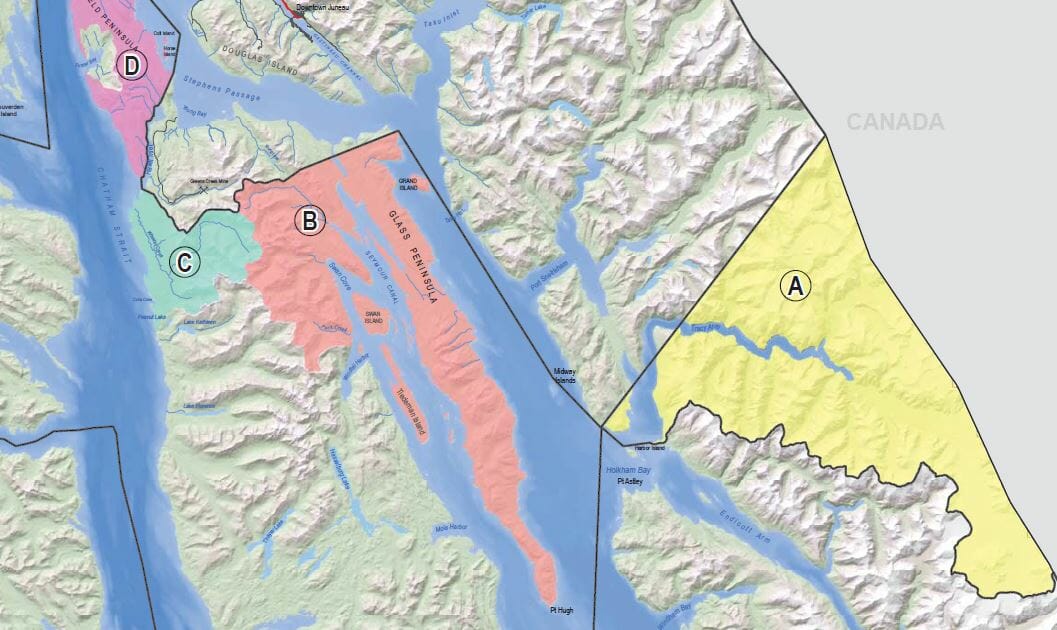
Q&A: CBJ’s Proposed Annexation Petition
What is annexation?
Annexation means to add territory to the boundaries of a borough government’s authority. In this instance, annexation means adding territory to the City and Borough of Juneau boundaries. Alaska’s constitution calls for the whole state to be in boroughs eventually. Annexation is a constitutionally-established means of fulfilling the purpose of Article X, Section 1 of Alaska’s Constitution, which is: “… to provide for maximum local self-government with a minimum of local government units, and to prevent duplication of tax-levying jurisdictions.” Annexation results in the extension of borough services, regulation, voting privileges, and taxing authority to the annexed area.
What areas does CBJ want to annex?
On June 14, CBJ filed a draft annexation petition for informal review with the State of Alaska Local Boundary Commission to annex the areas labeled A, B, C and D. All the areas are currently not in any borough, are adjacent to current borough boundaries, and – for the most part – are within state guidance on what areas should be part of the City and Borough of Juneau:
Area A is a triangular region on the mainland between Juneau’s southern boundary and the Petersburg Borough northern boundary. This area includes Tracy Arm. There are no known local residents or private properties there. This area is all within the Juneau Model Borough Boundary.
Area B includes Pack Creek, Oliver’s Inlet and the Glass Peninsula, areas on Admiralty Island where Juneau-based tours, commercial fishing, guided hunts and recreational activities are common. This area is all federally-owned property with the exception of Oliver Inlet State Marine Park. This area has a strong connection to Juneau and – with the exception of Pack Creek – is contained within the Juneau Model Borough Boundaries. Visitation to the Pack Creek area is managed by the U.S. Forest Service based in Juneau.
Area C is south of the Greens Creek Mine and encompasses all lands that drain into Wheeler Creek and lands to the west of the Wheeler Creek basin that drain directly into Chatham Strait. It contains private properties as well as USFS land. At present, there is no known significant economic or recreational activity there, though the potential exists for mineral exploration as an extension of current mining activity within existing CBJ boundaries.
Area D is the northern portion of Admiralty Island, including Horse and Colt Islands, but excluding the Funter Bay watershed. It contains private properties, some state and native corporation land, and USFS owned land. This area has strong connections to Juneau and is within the Juneau Model Borough Boundaries.
What is the Local Boundary Commission and what are Model Borough Boundaries?
The Local Boundary Commission (LBC) was created by the Alaska Constitution to ensure that arguments for and against proposals to create or alter municipal governments are analyzed objectively, and take areawide and statewide needs into consideration. The LBC will receive, review and make decisions on petitions for annexation. In 1997, the LBC adopted Model Borough Boundaries that serve as a general guide for existing and potential borough boundaries.
The areas proposed for annexation are within the CBJ’s Model Borough Boundaries, with the exception of small sections of Areas C and B which extend beyond the model boundary to ensure watersheds are not divided.
Why is CBJ pursuing annexation now?
In 2012, CBJ previously filed a petition for a swath of land between the southern boundary of Juneau and to the south to Cape Fanshaw and the southern watershed boundaries of Port Houghton and Dawes Glacier. This area was also requested by Petersburg in their petition for creation of the Petersburg Borough, and a large portion of this area has become part of the Petersburg Borough. What remains between the CBJ southern boundary and the Petersburg Borough northern boundary is a triangular area identified as current “Area A”.
The 2012 petition is outdated, and was postponed indefinitely by the Local Boundary Commission. CBJ is no longer seeking to annex property south of the Tracy Arm watershed, which is now part of the Petersburg Borough. The 2012 petition needs to be withdrawn or amended. Because annexation petitions are substantial undertakings, there’s efficiency in bundling more than one area in an application. When it comes to annexation, CBJ is best positioned to do it in a single petition.
On February 12, 2018, the Assembly adopted a resolution directing CBJ to file a new petition to include areas B, C, and D and the updated area A, and to file it as a petition for annexation by legislative review. Since then, CBJ staff members have been working to obtain the data and information for the annexation petition, and preparing the documents for review.
What is the process for annexation and how can the public get involved?
There will be extensive public process throughout the annexation process. LBC rules and regulations require significant notice and opportunities for public comment.
Following its informal review of CBJ’s draft petition, the LBC is likely to offer feedback. CBJ would then submit another draft petition for a technical review. Once a final petition is submitted to the LBC, LBC staff members go through a detailed process with more opportunities for public comment before the LBC approves, amends, or denies the petition.
The proposal could then go to the State Legislature for final approval. The soonest the boundary revision could go before the Legislature is during the 2020 legislative session.
What is the impact to the property owners if these areas are annexed into CBJ?
Property owners within borough boundaries, by state law, receive access to a minimum of government services: education, taxation, and planning, platting and land use regulation. Property owners will be able to vote in CBJ elections. In addition, CBJ provides EMS services throughout borough boundaries. These services are paid for by property tax and sales tax. The CBJ anticipates property tax revenue from private property within the proposed areas, as well as sales tax for commercial activity that occurs within the proposed areas.
Does annexation mean there will be any change in ownership of the land?
Annexation of the additional areas into the CBJ does not change the ownership of land. Property owned by private owners will remain the property of the private owners. Property owned by the federal government, state government, Alaska tribes or corporations will remain the property of these entities. A large majority of the land in the proposed annexation areas is owned by the U.S. Forest Service, which will not change by annexation.
Development of property will be subject to CBJ code as applicable. Any commercial building or primary residential building proposed within the annexation areas would be subject to the building code requirements and permitting of CBJ. Cabin structures used only occasionally for recreation and built in the proposed annexation areas would generally be exempt from needing to comply with the CBJ building code.
(Some of the information is from the State of Alaska Department of Commerce, Community and Economic Development’s Borough Annexation).
